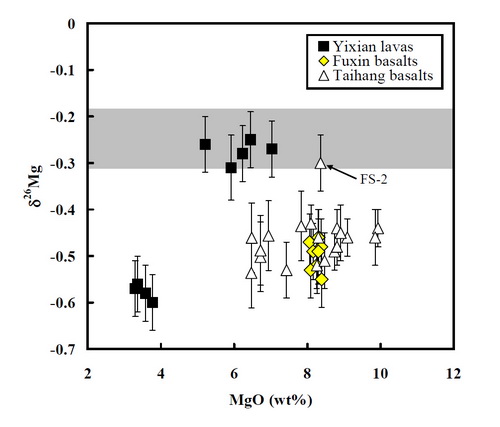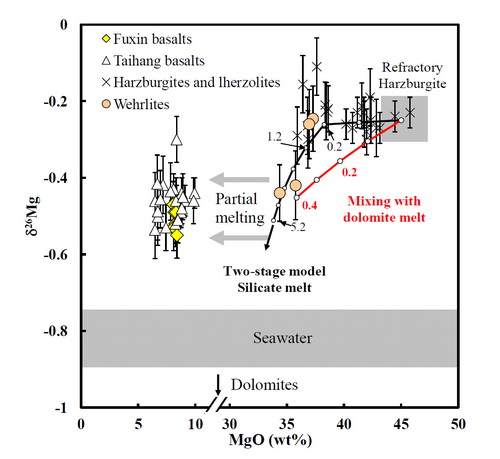Magnesium isotopic systematics of continental basalts from the North China craton: Implications for tracing subducted carbonate in the mantleUpdate time:12 10, 2012
Vice Professor YANG Wei and his team research the samples coming from a broad area in the North China craton to explore the possibility of tracing recycled carbonate by using Mg isotopes and to evaluate the effects of the western Pacific oceanic subduction on the upper mantle evolution of the North China craton. Their study not only presents an example to trace recycled carbonate using Mg isotopes but also confirms the important role of the western Pacific oceanic subduction in generating the <110 Ma basalts in the North China craton.
Fig. 1. δ26 Mg vs. MgO (wt.%) for the Yixian lavas, and the Fuxin and Taihang basalts. (Image by YANG)
Fig. 7. δ26 Mg vs. MgO (wt.%) for the Fuxin and the Fanshi basalts with the peridotites in the North China craton.(Image by YANG) Yang et al. Magnesium isotopic systematics of continental basalts from the North China craton: Implications for tracing subducted carbonate in the mantle. Chemical Geology. 2012. 328: 185-194 (Download Here)
|
Contact
Related Articles
Reference
|
-
SIMSSecondary Ion Mass Spectrometer Laboratory
-
MC-ICPMSMultiple-collector ICPMS Laboratory
-
EM & TEMElectron Microprobe and Transmission Electron Microscope Laboratory
-
SISolid Isotope Laboratory
-
StIStable Isotope Laboratory
-
RMPARock-Mineral Preparation and Analysis
-
AAH40Ar/39Ar & (U-Th)/He Laboratory
-
EMLElectron Microscopy Laboratory
-
USCLUranium Series Chronology Laboratory
-
SASeismic Array Laboratory
-
SEELaboratory of Space Environment Exploration Laboratory
-
PGPaleomagnetism and Geochronology Laboratory
-
BioMNSFrance-China Bio-mineralization and Nano-structure Laboratory

 Print
Print Close
Close

